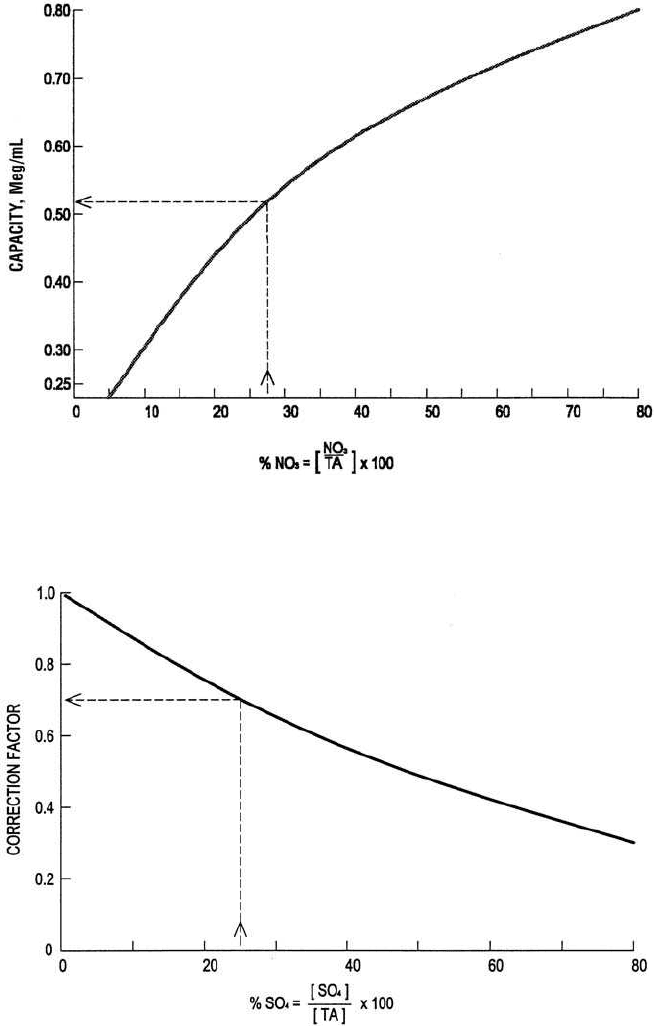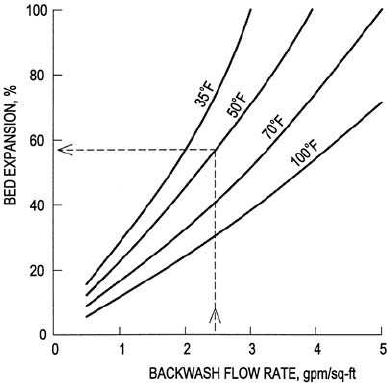Lin S.D. Water and Wastewater Calculations Manual
Подождите немного. Документ загружается.


13.1 Leakage
Leakage is defined as the appearance of a low concentration of the unde-
sirable ions in the column effluent during the beginning of the exhaus-
tion. It comes generally from the residual ions in the bottom resins due
to incomplete regeneration. Leakage will occur for softening process. A
water softening column is usually not fully regenerated due to inefficient
use of salt to completely regenerate the resin on the sodium form. The
leakage depends upon the ionic composition of the bed bottom and the
composition of the influent water.
A detailed example of step-by-step design method for a fix bed ion
exchange column for water softening is given by Benefield et al. (1982).
Example: The bottom of the water softener is 77% in the calcium form after
regeneration. The strong-acid cation resin has a total capacity of 2.0 eq/L and
selective coefficient for calcium over sodium is 2.6. Determine the initial cal-
cium leakage the water composition has as follows (in meq/L):
Ca
2⫹
⫽ 0.4 CI
–
⫽ 0.4
Mg
2⫹
⫽ 0.2 ⫽ 0.4
Na
⫹
⫽ 1.2 ⫽ 1.0
Total cations ⫽ 1.8 Total anions ⫽ 1.8
solution:
Step 1. Determine the equivalent fraction of calcium ion from the given:
Using Eq. (5.118)
Step 2. Calculate the initial calcium leakage y
5 0.010 meq/L
y 5 0.0056 c 5 0.0056 3 1.8 meq/L
0.77
s1 2 0.77d
2
5 2.6a
2
0.002
bc
X
Ca
s1 2 X
Ca
d
2
d
X
Ca
s1 2 X
Ca
d
2
5 0.0056
K
Ca
Na
5 2.6
C 5 2 meq/L 5 0.002 eq/L
C
5 2.0 eq/L
X
Ca
21
5 0.77
HCO
2
3
SO
22
4
Public Water Supply 425

13.2 Nitrate removal
Nitrate, is a nitrogen–oxygen ion that occurs frequently in nature
as the result of interaction between nitrogen in the atmosphere and
living things on earth. It is a portion of the nitrogen cycle. When plant
and animal proteins are broken down, ammonia and nitrogen gas are
released. Ammonia is subsequently oxidized to nitrite and nitrate
by bacterial action (Fig. 1.1).
High concentration of nitrate in drinking water may cause methe-
moglobinemia, especially for infants. Nitrates interfere with the body’s
ability to take oxygen from the air and distribute it to body cells. The
United States EPA’s standard for nitrate in drinking water is 10 mg/L.
In Illinois, the water purveyor must furnish special bottle water (low
nitrate) to infants if the nitrate level of the finished water exceeds the
standard.
The sources of nitrates to water are due to human activities.
Agricultural activities, such as fertilizer application and animal feed-
lots, are major contributors of nitrate and ammonia to be washed off
(runoff ) and percolate to soil with precipitation. The nitrates that are
polluted can subsequently flow into surface waters (streams and lakes)
and into groundwater. Municipal sewage effluents improperly treat
domestic wastewaters, and draining of septic tanks may cause nitrate
contamination in the raw water source of a waterworks. Identification
of pollution sources and protective alternatives should be taken.
If the nitrate concentration in the water supply is excessive, there are
two approaches for solving the problem, i.e. treatment for nitrate
removal and nontreatment alternatives. Nontreatment alternatives
may include (1) use new water source, (2) blend with low nitrate waters,
(3) connect to other supplier(s), and (4) organize in a regional system.
Nitrate is not removed by the conventional water treatment processes,
such as coagulation–flocculation, sedimentation, filtration, activated
carbon adsorption, and disinfection (chlorination and ozonation). Some
treatment technologies, such as ion exchange, reverse osmosis, electro-
dialysis, microbial denitrification, and chemical reduction, can remove
nitrates from drinking water. An ion exchange process design is given
as the following examples.
sNO
2
2
d
NO
2
3
,
5 0.50 mg/L as CaCO
3
5 0.20 mg/L as Ca
100 as CaCO
3
40 as Ca
5 0.20 mg/L as Ca
5 0.010
meq
L
3
20 mg as Ca
meq
426 Chapter 5

Two types (fixed bed and continuous) of ion exchangers are used. The
fixed bed exchange is used mostly for home and industry uses and is con-
trolled by a flow totalizer with an automatic regeneration cycle at
approximately 75% to 80% of the theoretical bed capacity. Continuous
ion exchangers are employed by larger installations, such as water-
works, that provide continuous product water and require minimum bed
volume. A portion of the resin bed is withdrawn and regenerated out-
side of the main exchange vessel.
In the design of an ion exchange system for nitrate removal, raw water
quality analyses and pilot testing are generally required. The type of
resin and resin capacity, bed dimensions, and regenerant requirement
must be determined. Basic data, such as the design flow rate through the
exchanger, influent water quality, total anions, and suggested operating
conditions for the resin selected (from the manufacturer) must be known.
Analysis of water quality may include nitrate, sulfate, chloride, bicar-
bonate, calcium carbonate, iron, total suspended solids, and total organic
carbon. For Duolite A-104, for example, the suggested design parameters
are listed below (Diamond Shamrock Co., 1978):
Parameters Recommended values
Minimum bed depth 30 in
Backwash flow rate 2–3 gpm/ft
2
Regenerant dosage 15–18 lb sodium chloride (NaCl) per ft
3
resin
Regenerant concentration 10–12% NaCl by weight
Regenerant temperature Up to 120°F or 49°C
Regenerant flow rate 0.5 gpm/ft
3
Rinse flow rate 2 gpm/ft
3
Rinse volume 50–70 gal/ft
3
Service flow rate Up to 5 gpm/ft
3
Operating temperature Salt form, up to 180°F or 85°C
pH limitation None
In design processes, resin capacity, bed dimensions, and regenerant
requirements must be computed. Resin capacity determines the quan-
tity of resin needed in the ion exchanger and is computed from a pilot
study. Data is provided by the manufacturer. For example, the operat-
ing capacity of Duloite A-104 resin for nitrate removal is quite depend-
ent upon the nitrate, sulfate, and total anion concentrations to calculate
the corrected resin capacity. The raw or uncorrected resin capacity is
determined by using the manufacturer’s graph (Fig. 5.7). This capacity
must be adjusted downward to reflect the presence of sulfate in the
water (Fig. 5.8), because sulfate anions will be exchanged before nitrate
(US EPA, 1983).
Once the adjusted resin capacity is determined for the water to be
treated, the required bed volume of the ion exchange resin can be
Public Water Supply 427

428 Chapter 5
Figure 5.7 Relationship of NO
3
/TA and unadjusted resin capacity for A-104 resin (US
EPA, 1983).
Figure 5.8 Correction factor for A-104 resin (US EPA, 1983).

calculated. The bed volume is the amount of nitrate that must be
removed in each cycle divided by the adjusted resin capacity. Using this
bed volume and minimum depth requirement, the surface area of resin
can be calculated. A standard size containment vessel can be selected
with the closest surface area. Using this standard size, the depth of the
resin can be recalculated. The final height of the vessel should be added
to a bed expansion factor during backwashing with a design tempera-
ture selected (Fig. 5.9).
Once the bed volume and dimensions are computed, the regenera-
tion system can be designed. The regeneration system must deter-
mine: (1) the salt required per generation cycle, (2) the volume of brine
produced per cycle, (3) the total volume of the brine storage tank, and
(4) the time needed for the regeneration process. The design of an ion
exchanger for nitrate removal is illustrated in the following three
examples.
Example 1: A small public water system has the maximum daily flow rate
of 100,000 gal/d, maximum weekly flow of 500,000 gal/week, and maximum
nitrate concentration of 16 mg/L. The plant treats 100,000 gal of water and
operates only 7 h/d and 5d/week (assume sufficient storage capacity for week-
end demand). Finished water after ion exchange process with 0.6 mg/L of
nitrate–nitrogen (NO
3
-N) will be blended with untreated water 16 mg/L of
NO
3
-N to produce a finished water of 8 mg/L or less of NO
3
-N. The NO
3
-N stan-
dard is 10 mg/L. Determine the flow rate of ion exchanger in gpm and the
blending rate.
Public Water Supply 429
Figure 5.9 Bed expansion curve for A-104 resin (modified from US EPA, 1983).

solution:
Step 1. Compute the quantity of water that passes the ion exchanger, q
1
Let untreated flow ⫽ q
2
and c, c
1
, and c
2
⫽ NO
3
-N concentrations in finished,
treated (ion exchanger) and untreated waters, respectively.
Then
c ⫽ 8 mg/L
c
1
⫽ 0.6 mg/L
c
2
⫽ 16 mg/L
by mass balance
(a)
since
(b)
Substituting (b) into (a)
Step 2. Compute flow rate in gpm to the exchanger (only operates 7 h/d)
Step 3. Compute blending ratio, br
Example 2: The given conditions are the same as in Example 1. The anion
concentration of the influent of the ion exchanger are: NO
3
-N ⫽ 16 mg/L,
SO
4
⫽ 48 mg/L, Cl ⫽ 28 mg/L, and HCO
3
⫽ 72 mg/L. Determine the total
quantity of nitrate to be removed daily by the ion exchanger and the ratios
of anions.
> 0.52
br 5
51,950 gpd
100,000 gpd
5 124 gpm
q
1
5 51,950
gal
d
3
24 h
7 h
3
1 day
1440 min
q
1
5 51,950 sgpdd
15.4q
1
5 800,000
06q
1
1 16s100,000 2 q
1
d 5 800,000
q
2
5 100,000 2 q
1
0.6q
1
1 16q
2
5 100,000 3 8
c
1
q
1
1 c
2
q
2
5 100,000c
430 Chapter 5

solution:
Step 1. Compute total anions and ratios
Concentration, Milliequivalent Concentration,
Anions mg/L weight, mg/meq meq/L Percentage
NO
3
-N 16 14.0 1.14 27.7
SO
4
48 48.0 1.00 24.4
Cl 28 35.5 0.79 19.2
HCO
3
72 61.0 1.18 28.7
Total 4.11
In the last column above for NO
3
-N
Step 2. Determine nitrate to be removed daily
The total amount of nitrates to be removed depends on the concentrations of
influent and effluent, c
i
and c
e
and can be determined by
nitrates removed (meq/d) ⫽ [(c
i
⫺ c
e
) meq/L] ⫻ q
1
(L/d)
Since
If the ion exchanger is going to operate with only one cycle per day, the quan-
tity of nitrate to be removed per cycle is 215,700 meq.
Example 3: Design a 100,000 gpd ion exchanger for nitrate removal using
the data given in Examples 1 and 2. Find resin capacity, resin bed dimension,
and regenerant requirements (salt used, brine production, the total volume
of the brine storage tank, and regeneration cycle operating time) for the ion
exchanger.
solution:
Step 1. Determine the uncorrected (unadjusted) volume of resin needed
(a) In Example 2, the nitrate to total anion ratio is 27.7%. Using 27.7% in Fig.
5.7, we obtain the uncorrected resin capacity of 0.52 meq/(NO
3
mL) resin.
(b) In Example 2, the sulfate to total anion ratio is 24.4%. Using 25% in
Fig. 5.8, we obtain the correction factor of resin capacity due to sulfate is 0.70.
5 215,700 meq/d
Nitrates removed 5 s1.14 2 0.043d meq/L 3 51,950 gpd 3 3.785 L/gal
5 0.043 meq/L
c
e
5 0.6 mg/L 4 14 mg/meq
c
i
5 1.14 meq/L
% 5 1.14 3 100/4.11 5 27.7
Public Water Supply 431

(c) The adjusted resin capacity is downward to
0.52 meq/mL ⫻ 0.70 ⫽ 0.364 meq/mL
(d) Convert meq/mL to meq/ft
3
Step 2. Determine the bed volume, BV
In Example 2, nitrate to be removed in each cycle is 215,700 meq
Step 3. Check the service flow rate, SFR
In Example 1, the ion exchange unit flow rate ⫽124 gpm
This value exceeds the manufacturer’s maximum SFR of 5 gpm/ft
3
. In
order to reduce the SFR, we can modify it either by: (a) increasing the
exchanger operating time per cycle, or (b) increasing the bed volume.
(a) Calculate adjusted service time, AST
Calculate the adjusted flow rate for the new cycle
In Example 1, q
1
⫽ 51,950 gpd or 51,950 gal/cycle
Alternatively
(b) Increase the bed volume and retain the initial unit flow rate
say 5 25 ft
3
5 24.7 ft
3
Adjusted BV 5 20.93 ft
3
3 s5.9 gpm/ft
3
/5.0 gpm/ft
3
d
5 104 gpm
5 51,950 gal/cycle/s8.3 h/cycle 3 60 min/hd
then, flow rate 5 q
1
/AST
5 8.3 h/cycle
AST 5
7 h
cycle
3
5.9 gpm/ft
3
5.0 gpm/ft
3
5 5.9 gpm/ft
3
SFR 5 124 gpm/BV 5 124 gpm/20.93 ft
3
5 20.93 ft
3
BV 5 215,700 meq 4 10,305 meq>ft
3
5 10,305 meq/ft
3
0.364 meq/mL 3 3785 mL/gal 3 7.48 gal/ft
3
432 Chapter 5

In comparison between alternatives (a) and (b), it is more desirable to
increase BV using 7 h/d operation. Thus BV ⫽ 25 ft
3
is chosen.
Step 4. Determine bed dimensions.
(a) Select the vessel size
Based on the suggested design specification, the minimum bed depth (z)
is 30 in or 2.5 feet. The area, A, would be
For a circular vessel, find the diameter
The closest premanufactured size is 3.5 ft in diameter with a correspon-
ding cross-sectional area of 9.62 ft
2
. The resin height, h, would then be
recalculated as
(b) Adjusting for expansion during backwash
Since allowable backwash flow rate is 2 to 3 gpm/ft
2
. If the backwash
rate is selected as 2.5 gpm/ft
2
with the backwash water temperature of
50°F, the percent bed expansion would be 58% as read from the curve in
Fig. 5.9. Thus, the design height (H ) of the vessel should be at least
Note: We use 3.5 ft diameter and 4.11 ft (at least) height vessel.
Step 5. Determine regenerant requirements
(a) Choice salt (NaCl) required per regeneration cycle since regenerant dosage
is 15 to 18 lb of salt per cubic foot of resin. Assume 16 lb/ft
3
is selected.
The amount of salt required is
We need 400 lb of salt per cycle.
5 400 lb
Salt 5 16 lb/ft
3
3 25 ft
3
5 4.11 ft
H 5 2.6 ft 3 s1 1 0.58d
5 2.6 ft
h 5 25 ft
3
/9.62 ft
2
5 3.57 ft
D 5 24A/p
5 24 3 10.0 ft
2
/3.14
A 5 pD
2
/4
5 10.0 ft
2
A 5 BV/z 5 25 ft
3
/2.5 ft
Public Water Supply 433

(b) Calculate volume of brine used per cycle
On the basis of the specification, the regenerant concentration is 10% to
12% NaCl by weight. Assume it is 10%, then
(c) Calculate total volume of brine
The specific weight of salt is 2.165
Note: The total volume of brine generated is 454 gal per cycle. The total
volume of the brine storage tank should contain sufficient capacity for 3 to 4
generations. Assume 3 cycles of brine produced should be stored, then the total
brine tank volume (V ) would be
(d) Calculate time required for regeneration cycle
The regeneration flow rate (Q) is 0.5 gpm/ft
3
resin specified by the manu-
facturer. Then
The regeneration time (t) is the volume of the brine per cycle divided by
the flow rate Q, thus
t 5 454 gal/12.5 gal/min
5 36.3 min
Q 5 0.5 gpm/ft
3
3 25 ft
3
5 12.5 gpm
V 5 454 gal/cycle 3 3 cycle
5 1362 gal
5 454 gal
Total volume in gallons 5 60.65 ft
3
3 7.48 gal/ft
3
5 60.65 ft
3
Total volume of the brine 5 57.69 ft
3
1 2.96 ft
3
5 2.96 ft
3
Volume of salt 5 400 lb/s62.4 lb/ft
3
3 2.165d
5 57.69 ft
3
Volume of water 5
wt. of water
density of water
5
3600 lb
62.4 lb/ft
3
5 3600 lb
Weight of water 5 s4000 2 400d lb/cycle
5 4000 lb
total wt. of brine 5 400 lb 3 100/10
Salt concentration, % 5
wt. of salt 3 100
total wt. of brine
434 Chapter 5
